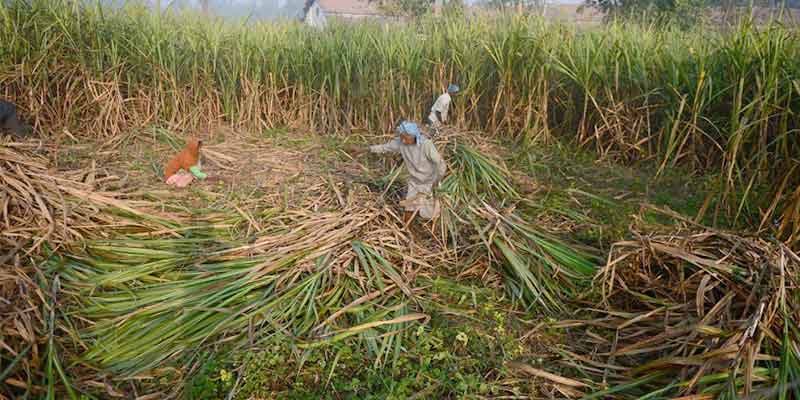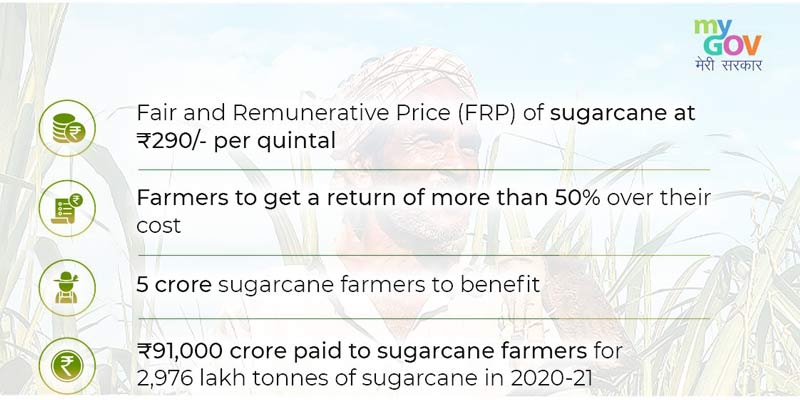- India
- Aug 26
How is the FRP of sugarcane fixed?
The Cabinet Committee on Economic Affairs has approved the Fair and Remunerative Price (FRP) of sugarcane for the 2021-22 marketing year (October-September) at Rs 290 per quintal.
What is FRP? How is it calculated?
• FRP is the minimum price that mills have to pay to sugarcane growers.
• With the amendment of the Sugarcane (Control) Order, 1966 on October 22, 2009, the concept of Statutory Minimum Price (SMP) of sugarcane was replaced with the ‘Fair and Remunerative Price (FRP)’ of sugarcane.
• The cane price announced by the central government is decided on the basis of the recommendations of the Commission for Agricultural Costs and Prices (CACP) in consultation with the state governments and after taking feedback from associations of sugar industry.
The amended provisions of the Sugarcane (Control) Order, 1966 provides for fixation of FRP of sugarcane having regard to the following factors:
1) Cost of production of sugarcane.
2) Return to the growers from alternative crops and the general trend of prices of agricultural commodities.
3) Availability of sugar to consumers at a fair price.
4) Price at which sugar produced from sugarcane is sold by sugar producers.
5) Recovery of sugar from sugarcane.
6) The realization made from sale of byproducts — molasses, bagasse and press mud or their imputed value.
7) Reasonable margins for the growers of sugarcane on account of risk and profits.
• Under the FRP system, the farmers are not required to wait till the end of the season or for any announcement of the profits by sugar mills or the government. This system also assures margins on account of profit and risk to farmers, irrespective of the fact whether sugar mills generate profit or not.
• In order to ensure that higher sugar recoveries are adequately rewarded and considering variations amongst sugar mills, the FRP is linked to a basic recovery rate of sugar, with a premium payable to farmers for higher recoveries of sugar from sugarcane.
Key points of FRP for 2021-22 marketing year:
• A premium of Rs 2.90/quintal will be provided for each 0.1 per cent increase in recovery over and above 10 per cent. There will be a reduction in FRP by Rs 2.90/quintal for every 0.1 per cent decrease in recovery.
• There would be no deduction where recovery is below 9.5 per cent.
• Such farmers will get Rs 275.50 per quintal for sugarcane in ensuing sugar season 2021-22 in place of Rs 270.75 per quintal in current sugar season 2020-21.
• The cost of production of sugarcane for the sugar season 2021-22 is Rs 155 per quintal. The FRP of Rs 290 per quintal at a recovery rate of 10 per cent is higher by 87 per cent over production cost, thereby giving the farmers a return of much more than 50 per cent over their cost.
• The decision will benefit around five crore sugarcane farmers and their dependents, as well as about five lakh workers employed in sugar mills and related ancillary activities.
• The FRP approved shall be applicable for purchase of sugarcane from the farmers in the sugar season 2021-22 (starting from October 1, 2021) by sugar mills.
• In the current sugar season 2020-21, about 2,976 lakh tonnes of sugarcane of worth Rs 91,000 crore was purchased by sugar mills. It is the highest ever procurement and second only to the procurement of paddy crop at Minimum Support Price.
• Keeping the expected increase in the production of sugarcane in the ensuing sugar season 2021-22, about 3,088 lakh tonnes of sugarcane is likely to be purchased by sugar mills.
• The total remittance to the sugarcane farmers will be about Rs 1 lakh crore.
• The FRP has been determined on the basis of recommendations of Commission for Agricultural Costs and Prices (CACP) and after consultation with state governments and other stake-holders.
Promoting ethanol
• The government is encouraging sugar mills to divert excess sugarcane to ethanol which is blended with petrol, which not only serves as a green fuel but also saves foreign exchange on account of crude oil import.
• In the past three sugar seasons, about Rs 22,000 crore revenue was generated by sugar mills/ distilleries from the sale of ethanol to Oil Marketing Companies (OMCs).
• In the current sugar season 2020-21, about Rs 15,000 crore revenue is being generated by sugar mills from sale of ethanol to OMCs at 8.5 per cent.
• Ethanol blending in petrol will rise to 20 per cent in the next three years from the current level.
• Increase in export and diversion of sugarcane to ethanol is ensuring timely cane price payments to farmers and added cane growers now do not have to wait for a long to get payment from mills.
Additional read:
What is the process to fix MSP?
The Commission for Agricultural Costs & Prices (CACP) is an attached office of the ministry of agriculture and farmers welfare. It was established in January 1965. It is mandated to recommend MSPs to incentivise the cultivators to adopt modern technology, and raise productivity and overall grain production in line with the emerging demand patterns in the country.
Manorama Yearbook app is now available on Google Play Store and iOS App Store




